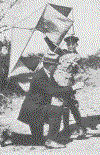By Leslie Hunt

FIG. 52.
BACK FRAME FOR THE TRIANGULAR BOX KITE WITH WINGS
Observe that the square in the center is not papered.
A number of kites have appeared in toy stores that have the elements of plane-surface kites combined with the elements of kites with more than one plane surface. Some fly very well, but many are indifferent fliers because the extra surface has been overdone. It has been mentioned elsewhere that the plane surface should not be greater than the surfaces not in the same plane, unless one wishes to attach a tail to the kite.
It will be found a good plan to have the plane surfaces or wings a little smaller than the surfaces of the box or keel part of the kite. If a Compound Kite is then unsatisfactory in flying behavior, it is probably because the open space in the center is too small. The open space in the keel or box part of a Compound Kite should be from one third to two thirds the length of the upright sticks.
The bridle should be attached so the towing point is from one sixth to one fourth the length of the upright sticks from the top of the kite.
This kite may be made like the Triangular Box Kite and the wings added, but I find the following way to be better. Prepare four sticks 3/16 by 3/16 by 26 inches for uprights. Prepare one stick 1/4 by 3/8 by 26 inches for the cross or wing spreader. Six sticks 3/16 by 3/16 by 10 inches complete the material for the frame.
Lay two uprights parallel to each other, 9 inches apart; even the ends and mark the sticks 9 inches from each end. Glue and lash the sticks in the position shown in Figure 52.
Treat the framing and stick ends according to the method described for kite No. 1. Glue the paper to the sticks, and cut out the center of the kite as shown. It will be seen that the center panel of the kite is divided into thirds, the middle third being cut out. As a matter of fact, you will probably find that the kites fly a little better if the lower part of the center panel is a trifle more than a third. For a kite using 26-inch sticks, the upper part should be 8 1/2 inches and the lower part about 9 1/4 inches wide.

FIG. 53.
SIDES OF THE TRIANGULAR KEEL ATTACHED TO THE BACK FRAME
Notice the sticks that hold the triangular box taut.
Lay the kite on the floor, frame up, and attach the paper and the remaining sticks as shown in Figure 53. When dry, swing the sides of the box forward, tie the two forward sticks together in three or four places and the kite is ready for the bridle. Tie a tow string at the place designated by the circle and letter A in Figure 54.

FIG. 54.
TRIANGULAR BOX KITE WITH WINGS COMPLETE
Towing point will fall near the place marked A.
The towing point will have to be changed according to the strength of the wind, but it will always be from 4 1/2 to 6 1/2 inches from the top of the kite. The kite made from the foregoing description weighed .80 ounce per square foot. It was an excellent flier.
If wider wings are desired, a longer stick may be made by gluing and wrapping two sticks together for two or three inches, or a stick may be cut from other material. But remember the principle that the wings must be of less area than the box, unless you wish to fly the kite with a tail. The usefulness of this kind of kite to explorers is mentioned below.

THE KITE USED IN LIEUT. COMMANDER BYRD'S POLAR EXPEDITION
Samuel F. Perkins, the government kite maker, is shown attaching an aerial to
one of the kites used by Lieut. Commander Byrd on his Polar expedition, to be
used in case of a forced landing. (Keystone View Co.)